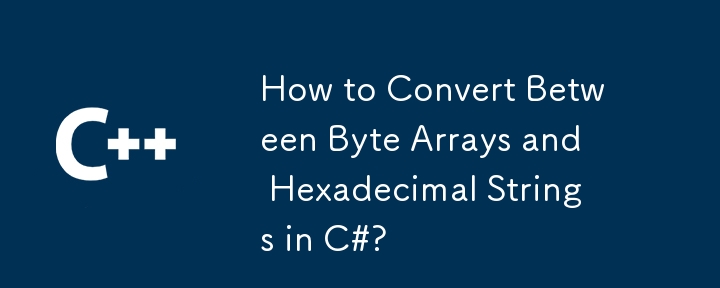How to Convert Between Byte Arrays and Hexadecimal Strings in C#?
Feb 03, 2025 am 08:13 AM 
In programming, the conversion between byte array and hexadecimal string is a common task. This article will introduce how to achieve this conversion in C#:
Converted from byte array to hexadecimal string
From the .NET 5, you can use the built -in method to complete this task:
Convert.ToHexString The converted from the hexadecimal string to the byte array
string hexString = Convert.ToHexString(byteArray);
For reverse operation, please use :
<舊> The alternative method of the old version .NET version Convert.FromHexString
byte[] byteArray = Convert.FromHexString(hexString);If you are using the old version .NET, you can use the following methods:
or: <或者>
<向> reverse conversion
public static string ByteArrayToString(byte[] ba)
{
StringBuilder hex = new StringBuilder(ba.Length * 2);
foreach (byte b in ba)
hex.AppendFormat("{0:x2}", b);
return hex.ToString();
}
To convert the hexadecimal string conversion tote array, please use this method:
public static string ByteArrayToString(byte[] ba)
{
return BitConverter.ToString(ba).Replace("-", "");
}
Optimize
In order to improve performance, you can consider using alternatives to avoid string -based conversion. However, for most scenarios, the method introduced here should be sufficient.The above is the detailed content of How to Convert Between Byte Arrays and Hexadecimal Strings in C#?. For more information, please follow other related articles on the PHP Chinese website!

Hot AI Tools

Undress AI Tool
Undress images for free

Undresser.AI Undress
AI-powered app for creating realistic nude photos

AI Clothes Remover
Online AI tool for removing clothes from photos.

Clothoff.io
AI clothes remover

Video Face Swap
Swap faces in any video effortlessly with our completely free AI face swap tool!

Hot Article

Hot Tools

Notepad++7.3.1
Easy-to-use and free code editor

SublimeText3 Chinese version
Chinese version, very easy to use

Zend Studio 13.0.1
Powerful PHP integrated development environment

Dreamweaver CS6
Visual web development tools

SublimeText3 Mac version
God-level code editing software (SublimeText3)

Hot Topics
 C Polymorphism: Enhancing Code Reusability and Flexibility
Jun 10, 2025 am 12:04 AM
C Polymorphism: Enhancing Code Reusability and Flexibility
Jun 10, 2025 am 12:04 AM
Polymorphism in C is implemented through virtual functions and abstract classes, enhancing the reusability and flexibility of the code. 1) Virtual functions allow derived classes to override base class methods, 2) Abstract classes define interfaces, and force derived classes to implement certain methods. This mechanism makes the code more flexible and scalable, but attention should be paid to its possible increase in runtime overhead and code complexity.
 What Are C Destructors? Explained for Beginners
Jun 09, 2025 am 12:04 AM
What Are C Destructors? Explained for Beginners
Jun 09, 2025 am 12:04 AM
C destructorsarespecialmemberfunctionsautomaticallycalledwhenanobjectgoesoutofscopeorisdeleted,crucialforresourcemanagement.1)Theyensureresourcesarereleasedproperly,preventingmemoryleaks.2)Destructorsautomatecleanup,reducingerrors,andarekeytoRAII.3)
 C Polymorphism : is function overloading a kind of polymorphism?
Jun 20, 2025 am 12:05 AM
C Polymorphism : is function overloading a kind of polymorphism?
Jun 20, 2025 am 12:05 AM
Yes, function overloading is a polymorphic form in C, specifically compile-time polymorphism. 1. Function overload allows multiple functions with the same name but different parameter lists. 2. The compiler decides which function to call at compile time based on the provided parameters. 3. Unlike runtime polymorphism, function overloading has no extra overhead at runtime, and is simple to implement but less flexible.
 C Destructors code samples
Jun 13, 2025 am 12:04 AM
C Destructors code samples
Jun 13, 2025 am 12:04 AM
The destructor in C is used to free the resources occupied by the object. 1) They are automatically called at the end of the object's life cycle, such as leaving scope or using delete. 2) Resource management, exception security and performance optimization should be considered during design. 3) Avoid throwing exceptions in the destructor and use RAII mode to ensure resource release. 4) Define a virtual destructor in the base class to ensure that the derived class objects are properly destroyed. 5) Performance optimization can be achieved through object pools or smart pointers. 6) Keep the destructor thread safe and concise, and focus on resource release.
 What Are the Different Kinds of Polymorphism in C ? Explained
Jun 20, 2025 am 12:08 AM
What Are the Different Kinds of Polymorphism in C ? Explained
Jun 20, 2025 am 12:08 AM
C has two main polymorphic types: compile-time polymorphism and run-time polymorphism. 1. Compilation-time polymorphism is implemented through function overloading and templates, providing high efficiency but may lead to code bloating. 2. Runtime polymorphism is implemented through virtual functions and inheritance, providing flexibility but performance overhead.
 How to Implement Polymorphism in C : A Step-by-Step Tutorial
Jun 14, 2025 am 12:02 AM
How to Implement Polymorphism in C : A Step-by-Step Tutorial
Jun 14, 2025 am 12:02 AM
Implementing polymorphism in C can be achieved through the following steps: 1) use inheritance and virtual functions, 2) define a base class containing virtual functions, 3) rewrite these virtual functions by derived classes, and 4) call these functions using base class pointers or references. Polymorphism allows different types of objects to be treated as objects of the same basis type, thereby improving code flexibility and maintainability.
 C : Is Polymorphism really useful?
Jun 20, 2025 am 12:01 AM
C : Is Polymorphism really useful?
Jun 20, 2025 am 12:01 AM
Yes, polymorphisms in C are very useful. 1) It provides flexibility to allow easy addition of new types; 2) promotes code reuse and reduces duplication; 3) simplifies maintenance, making the code easier to expand and adapt to changes. Despite performance and memory management challenges, its advantages are particularly significant in complex systems.
 C Destructors: Common Errors
Jun 20, 2025 am 12:12 AM
C Destructors: Common Errors
Jun 20, 2025 am 12:12 AM
C destructorscanleadtoseveralcommonerrors.Toavoidthem:1)Preventdoubledeletionbysettingpointerstonullptrorusingsmartpointers.2)Handleexceptionsindestructorsbycatchingandloggingthem.3)Usevirtualdestructorsinbaseclassesforproperpolymorphicdestruction.4






